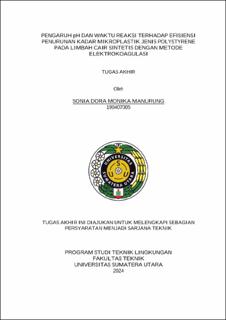| dc.contributor.advisor | Hafni, Kartini Noor | |
| dc.contributor.author | Manurung, Sonia Dora Monika | |
| dc.date.accessioned | 2024-08-14T07:22:02Z | |
| dc.date.available | 2024-08-14T07:22:02Z | |
| dc.date.issued | 2024 | |
| dc.identifier.uri | https://repositori.usu.ac.id/handle/123456789/95427 | |
| dc.description.abstract | One type of plastic polymer that can produce microplastics is polystyrene. When plastic
waste is thrown into water, it can gradually decompose through chemical, physical and
biological processes, producing microplastics, which are small plastic particles.
Microplastics can enter the food chain and undergo biomagnification. One processing
method that can be used to reduce the amount of microplastics is electrocoagulation.
The aim of this research is to find out how effective electrocoagulation is in reducing
levels of polystyrene microplastics. This is done by applying variations in pH and
residence time in minutes. In this study, the ideal microplastic removal efficiency level
was 73.70%. | en_US |
| dc.language.iso | id | en_US |
| dc.publisher | Universitas Sumatera Utara | en_US |
| dc.subject | Electrocoagulation | en_US |
| dc.subject | Polystyrene | en_US |
| dc.subject | Microplastic Removal Efficiency | en_US |
| dc.subject | SDGs | en_US |
| dc.title | Pengaruh pH dan Waktu Reaksi terhadap Efisiensi Penurunan Kadar Mikroplastik Jenis Polystyrene pada Limbah Cair Sintetis dengan Metode Elektrokoagulasi | en_US |
| dc.title.alternative | The Effect of pH and Reaction Time on The Efficiency of Reducing Levels of Polystyrene Microplastics in Synthetic Liquid Waste using The Electrocoagulation Method | en_US |
| dc.type | Thesis | en_US |
| dc.identifier.nim | NIM190407005 | |
| dc.identifier.nidn | NIDN0021046304 | |
| dc.identifier.kodeprodi | KODEPRODI25201#Teknik Lingkungan | |
| dc.description.pages | 67 Pages | en_US |
| dc.description.type | Skripsi Sarjana | en_US |


